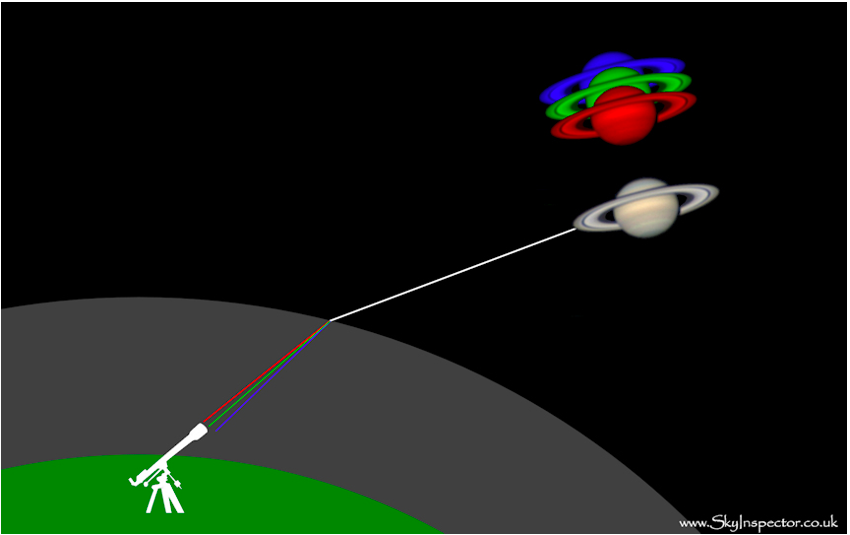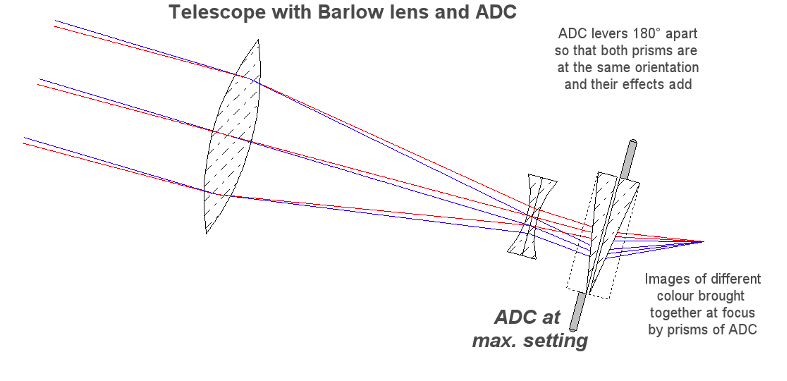Atmospheric Dispersion Part 1 – Problem and Solution
Originally published as ‘Atmospheric dispersion, Part 1: Problem & Solution’, BAA Journal Vol 131, No. 5, Oct 2021, E&T section, p276.
By Martin Lewis
After passing through Sagittarius, Jupiter and Saturn are now slowly moving northwards in the sky. Jupiter finally crosses the celestial equator next summer, but Saturn will still remain south of the equator until spring 2026. For observers in the UK, southern planetary declinations like this mean relatively short apparitions and low altitudes at culmination. Other planets, such as Venus and Mercury, even if well north of the equator, are often observed around dawn or dusk when they are also at lowish altitudes. Low altitude imaging or observing means that you are looking at these objects through a greater thicknesses of turbulent atmosphere. This generally means poorer seeing and lower resolution views, however, even on the rare occasions when the seeing might be unusually steady, views will always be adversely affected by a second phenomenon called atmospheric dispersion.
Atmospheric dispersion occurs when light from a distant object strikes the earth’s atmosphere at an angle. When this happens the atmosphere acts like a giant prism – bending the light downwards by an angle which is wavelength dependent. The result is that the observer sees the object elevated by an amount related to the wavelength of light. The object is then cloaked in a mini-spectrum with red at the bottom to blue at the top. The lower the object is in the sky, the shallower the angle of the incoming light and the greater the deflection. This results in a worse degree of atmospheric dispersion and so a worse level of colour smearing.

Atmospheric dispersion reduces resolution by causing an effective elongation of the airy disc, which is the best-focused spot of light that a perfect lens with a circular aperture can make and which is limited by the diffraction of light. This extension of the airy disc makes the minimum resolution worse in the vertical direction.
Combating Atmospheric Dispersion in Imaging with RGB Align
For RGB colour imaging with mono cameras you do naturally reduce the effects of atmospheric dispersion to some degree. By taking images through separate red, green or blue filters then recombining them in stacking programs like Registax or Autostakkert! the programs will attempt to realign the three separated colours to produce one full colour image. Unfortunately they will not be able to correct for any vertical spread occurring within each individual colour band. The issue here is that you can still get significant dispersion within the range of wavelengths passed by one filter. The shorter the wavelength the worse the degree of dispersion, consequently the blue filtered image is the most affected, then the green, whilst infra-red views are hardly affected at all.
Compared to mono cameras doing RGB imaging, one-shot colour cameras are even more affected by atmospheric dispersion. The bayer colour filter elements which sit over each pixel for the CMOS/CCD chip on a colour camera, have to be a compromise for lots of different properties, particularly the ability to successfully pattern them photolithographically. As a result, their wavelength acceptance window is invariably wider than those for dedicated R, G or B filters used with mono cameras. This means more smearing within each colour band and a resulting greater loss of overall resolution.
ADCs to the rescue
Fortunately commercial devices now exist that can significantly reduce the worst of these atmospheric dispersion effects. This device is called an atmospheric dispersion corrector (ADC) and is an essential piece of equipment for high resolution imaging of planets when they fall below about 35° altitude. Such a device will also benefit visual observers – the colour dispersion effects that plague low altitude camera images, will clearly also affect the same views in the eyepiece.

Atmospheric dispersion correctors (ADCs) have a pair of circular narrow angle prisms which can be rotated in opposite directions to each other to effectively create a single prism of variable power. The total deflecting angle imparted is usually settable from 0° up to 4° or 5°. As the deflecting power changes so does the degree of colour dispersion that the glass imparts. The idea is to set the orientation and dispersive power of the prism arrangement to just cancel out the dispersion induced by the atmosphere. When correctly set, the colour separated-images are brought back together at the focal plane, cancelling out the colour smearing from the atmospheric dispersion.
The ADC won’t do anything about the poorer seeing at low altitude, but when correctly set it will cancel the dispersion allowing more detailed views and images of the planets- and the lower the altitude the greater the relative benefit.
The ADC is generally placed after the Barlow lens in your imaging system and the prisms act to recombine the different wavelengths split apart by the atmosphere.

Premium non-professional ADCs are made by Pierro Astro and Astro Systems, Holland, both of which are priced around the £300 mark. ZWO and other suppliers such at Omegon and Altair Astro have more recently brought out lower cost versions made in China which are in the £100-£150 range – the cost of a lower end premium eyepiece.
In part two of this article, we shall discuss how to set-up, and use an ADC. For more information on ADCs and atmospheric dispersion see: www.skyinspector.co.uk/atm-dispersion-corrector-adc/
| The British Astronomical Association supports amateur astronomers around the UK and the rest of the world. Find out more about the BAA or join us. |
